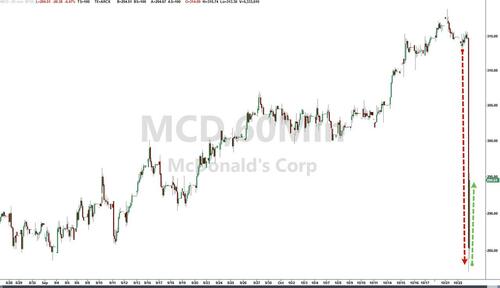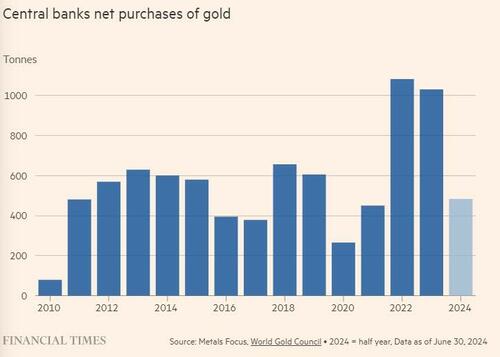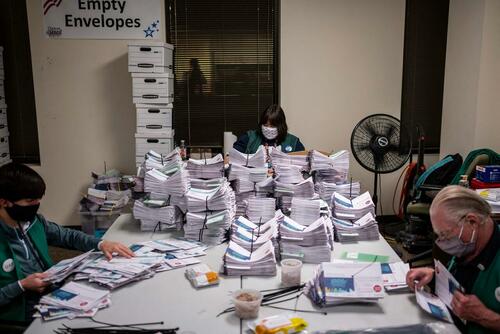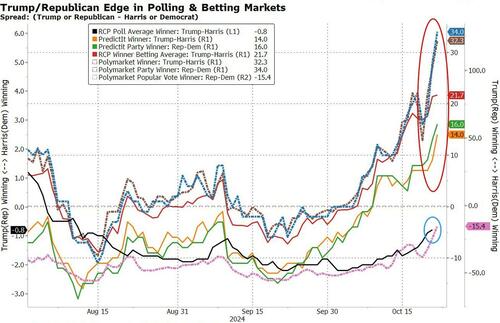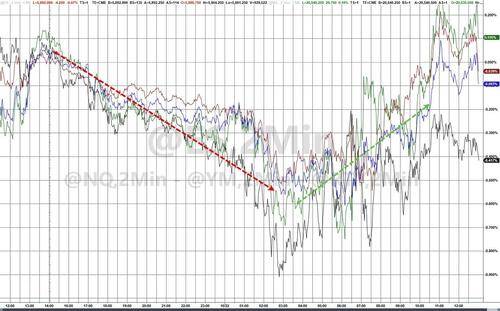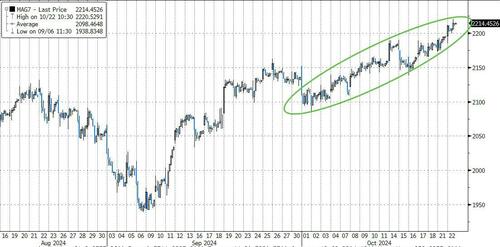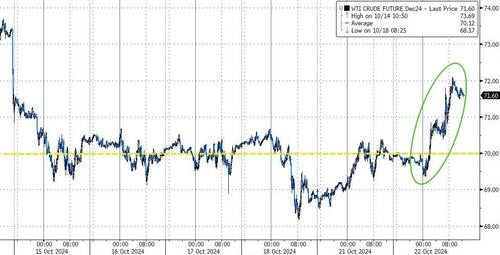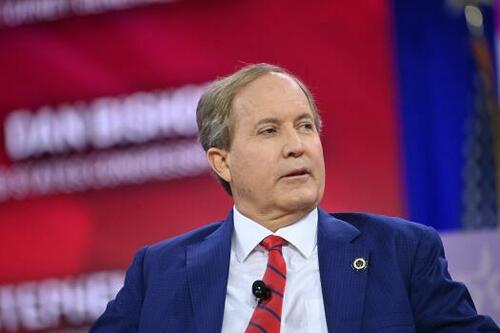Authored by Nick Corbishley via Naked Capitalism,
Mexico is the leading consumer of soft drinks in the world with an average consumption of 163 litres per person per year – 40% more than the US in second place. Child and adult obesity are off the charts.

Yesterday (Oct. 21), while Donald Trump was causing a stir by donning a McDonald’s uniform for the cameras and frying some fries, Mexico’s new Secretary of Public Education, Mario Delgado, announced the launch of a new nationwide program that is unlikely to be replicated north of the border any time soon. The goal of the program, titled “Vida Saludable” (Healthy Life), is to improve the nutrition and overall health of Mexican school children amid an epidemic of child obesity and diabetes.
The program, enacted by the now-former AMLO administration on September 29, has four main pillars: prevent the sale of ultra-processed food and sugary drinks in school settings; promote the consumption of natural drinking water through the provision of water fountains; train educators in healthy nutrition; and promote sports and physical activity. The Claudia Sheinbaum government, still in its maiden month in office, has said it will also train the heads of school cooperatives to sell fruits, vegetables and seasonal foods.
A Six-Month Deadline
“Vida Saludable” will become mandatory for all state schools at all levels of the national education system on March 29. Schools will have just six months to end all sales of foods and drinks that have at least one health warning label from their snack stands, or their administrators could face steep fines.
Of course, many children bring food from home, but the government says it has no intention of sanctioning parents who put junk food in their children’s lunchboxes. Instead, it will focus on explaining the harmful effects of these foods and the importance of eating a balanced diet.
Implementing “Vida Saludable” is likely to be difficult, however. At most of Mexico’s 255,000 public schools, free drinking water is not available to students. Since 2020, only 4% of them have managed to install drinking fountains. There are also doubts about how the government will enforce the ban on the pavements outside schools, where vendors set up stalls of goods to sell to kids at breaktime. This being Mexico, one can expect a lively black market in comida chattara to spring up in many schools. Enterprising students will no doubt get rich.
Nonetheless, drastic steps are necessary to combat Mexico’s soaring levels of child obesity and diabetes. An estimated 5.7 Mexican million children between the ages of 5 and 11 and 10.4 million adolescents between the ages of 12 and 19 are overweight or obese. In addition, an estimated 7 out of 10 schoolchildren and 5 out of 10 adolescents are physically inactive, which further aggravates the country’s public health crisis.
Mexico’s secretary of education blames these trends on the “high consumption of sugars”, the lack of physical activity and the food policies of previous governments, driven primarily by the profit-maximising needs of the food industry:
“In the neoliberal era they were not concerned about this situation — on the contrary, the sale of these products was promoted and there were even campaigns against hunger promoted by the companies that produce these junk foods. The neoliberal model turned rights such as education, health and food into merchandise.”
The Role of NAFTA
In Mexico, obesity reached epidemic proportions after it joined NAFTA with the United States and Canada in the early 1990s, making processed food more easily available. As the New York Times reported in a 2017 investigation, the commercial opening of North America turbocharged the growth of convenience stores and US-owned fast food restaurants on Mexican soil. In addition, trade liberalisation allowed “cheap corn, meat, high-fructose corn syrup, and processed foods” from the United States to flood into Mexico.
Diets quickly changed as many people, particularly those on lower incomes, replaced largely healthy traditional staples (corn tortilla, frijoles, Jamaica Water…) with highly processed alternatives (hotdogs, nuggets, sodas…). Granted, prior to NAFTA Mexico was already home to a burgeoning junk food industry, but what came after was on a whole different scale.
Mexico is now the leading consumer of soft drinks in the world with an average consumption of 163 litres per person per year — 40% more than the US in second place, with 118 litres, according to a 2022 study from the University of Yale. Incredibly, there is one state in the country that consumes Coca Cola in per-capita volumes five times higher than the national average and 32 times higher than the global average: Chiapas, Mexico’s poorest state.
“It is the epicentre of the epidemic of soft drink consumption,” Dr. Marcos Arana, a researcher at the Salvador Zubirán National Institute of Medical Sciences and Nutrition, told BBC Mundo:
Soft drinks are already an essential part of daily life in this state, especially in the Los Altos region of Chiapas, where the majority of its population is indigenous and rural…
“The availability and advertising of something so cheap is so great and omnipresent in Chiapas in the face of vulnerable populations that they have created an addiction that is seen as a necessity,” Arana says.
“Residents told me that before the road to Tenejapa arrived, there was no diabetes or cardiovascular problems there. That all began when the road arrived in town and the soft drinks, the chips…”, says Jaime Page Pliego, anthropologist and co-author of the study.
Local organizations such as the Centre for Training in Ecology and Health for Peasants (CCESC), which Arana directs, point to the “aggressive” commercial practices of soft drink companies and the easy accessibility of their products in the area as the main drivers of this excessive consumption.
“Coca-Cola is the most available product in Los Altos, you have to walk the farther to buy tortillas or anything else. The number of points of sale is excessive, without any control, and with prices reduced by up to 30%,” says Arana.
As sugar consumption in Mexico has soared, waistlines have exploded. In the past 20 years the number of obese and overweight people has tripled, with a staggering 75% of the population and 35% of the child population now overweight. In addition to obesity, the change in diet has contributed to diabetes becoming the second leading cause of death, after heart disease and ahead of cancer. In 2016, a state of epidemiological emergency was declared in the country due to the high rates of obesity and diabetes.
Food Labelling, Bans on Cartoon Food Packaging…
“Vida Saludable” is not the first step Mexico’s government has taken to try to improve Mexicans’ food habits. In October 2020, at the height of the COVID-19 pandemic, the AMLO government passed one of the strictest food labelling laws on the planet. From that date, all soft drinks cans and bottles, bags of chips and other processed food packages must bear black octagonal labels warning of “EXCESS SUGAR”, “EXCESS CALORIES”, “EXCESS SODIUM” or “EXCESS TRANS FATS” — all in big bold letters that are impossible to miss.
Today, more than half of Mexican food and beverage products have a nutritional warning label — more than any other country in Latin America. The government also banned cartoon food packaging aimed at children.
Big Food lobbies tried to block both of these measures, of course — just as they will no doubt try to block “Vida Saludable”. The Interamerican Association for the Protection of Intellectual Property and the Mexican Association for the Protection of Intellectual Property complained that food labelling was unconstitutional and violated the provisions that Mexico had signed at the international level such as the North American Free Trade Agreement — a tactic that has apparently been used in other jurisdictions where food labelling laws have been passed.
For almost four years the lawsuits dragged on. Of the more than 100 injunctions filed by companies like Coca-Cola Femsa, PepsiCo, Group Bimbo, Hershey’s, Santa Clara, Herdez, Alimentos del Fuerte, Nutrisa and McCormick, three reached the second chamber of the Supreme Court of Justice of the Nation (SCJN), which, to its credit, ruled – by unanimous vote – that front-of-pack labelling for food and non-alcoholic beverages is a valid measure that protects people’s health and consumers’ right to information.
The first country in Latin America to really begin tackling the public’s addiction to junk food, sugary drinks and ultra processed foods was Chile. In 2016, it passed a strict food labelling law. Like Mexico, it has also also limited cartoon food packaging, prevented schools from selling unhealthy foods, restricted TV adverts, and banned promotional toys. Over the next two years, sugary drink sales in Chile fell by 23%. According to one study, the labels reduced the likelihood of people choosing sugary breakfast cereals by 11% and sugary juices by almost 24%.
As I wrote in 2020 for WOLF STREET, it was one of the worst possible nightmares for the junk food industry. The fact that Chile, with its population of around 20 million people, was doing it was bad enough. The prospect of something similar transpiring in Mexico, a country with a population almost seven times larger than Chile and that consumes more processed food than any other country in Latin America and more soda on a per-capita basis than any country on the planet, unnerved global food and beverage companies:
The United States, EU, Canada and Switzerland, home to some of the world’s biggest food companies, tried to pause or derail the new legislation. But to no avail. The arrival of Covid-19, which has proven to be particularly lethal to people with three comorbidities — obesity, diabetes, and hypertension — has strengthened the government’s case and resolve.
The [government’s labelling laws] have raised concerns that [it] is overstepping its bounds. The business lobby group Coparmex said that banning the sale of junk food and sugary drinks to minors represents a frontal attack on commercial freedom and freedom of choice. It will also have serious economic consequences for businesses in the retail sector. But those consequences are dwarfed by the economic and health impact of widespread obesity.
Since 2020, many other countries in Latin America have introduced strict front-of-package food labelling laws, including Brazil, Argentina, Peru and Colombia. According to the Mexican online news website Sin Embargo, the labelling legislation in Mexico has had two main visible effects: the first is the reformulation of products by companies such as Bimbo, Nestlé and Kellogg’s, in an attempt to lower the concentration of ingredients that have excess sugar, fat or sodium. The second is the testimonials of consumers who claim to have reduced their consumption of products that bear health warnings on their packaging.
A study published in June in the International Journal of Behavioral Nutrition and Physical Activity suggests that the policy appears to be bearing fruit (pun intended). The study’s authors asked people aged 14 or over to self-report any perceived changes in their shopping habits a year after the food labelling law came into effect. More than a third of young people and almost half of adults said the labelling system had led them to reduce their purchase of various unhealthy foods. In addition, adults who reported higher water intake and lower consumption of sugary drinks said the main reason for this decision was food labelling.
Is it any surprise that the junk food industry spent years furiously lobbying in Mexico’s Congress to block the introduction of strict and clear front-of-package food labels, and once they were finally introduced spent another four years trying to get them overturned? The lobbies will no doubt try to do the same with Mexico’s “Vida Saludable” program, just as the US’ corn and GMO lobbies are using ISDS to try to prevent Mexico from banning the use of GMO corn for direct human consumption. It is no easy task for a country to mend its eating ways these days, especially if its direct neighbour is the US of A.

